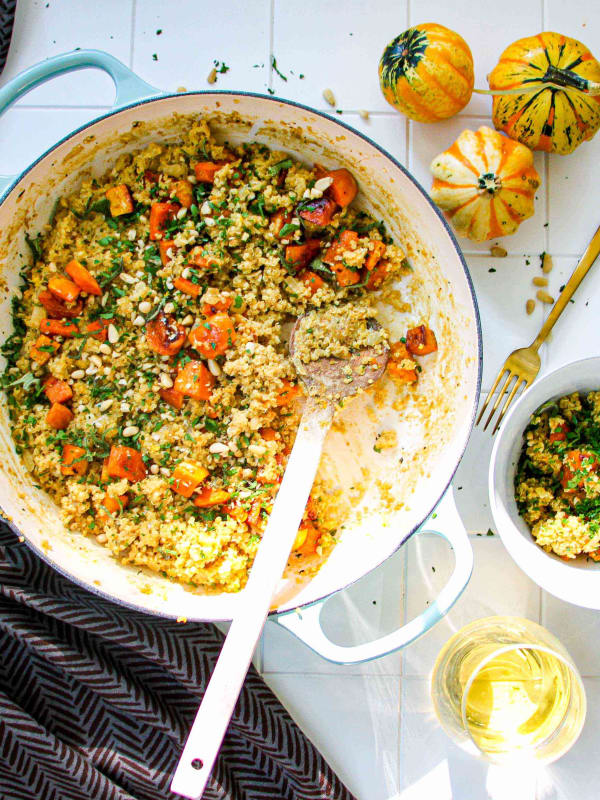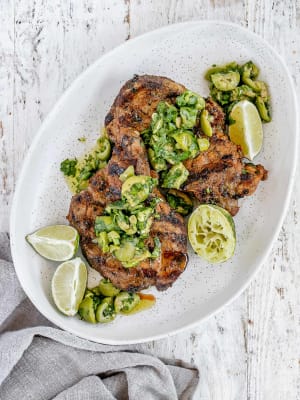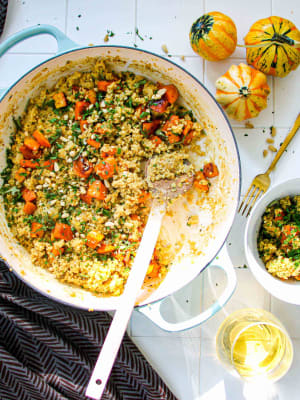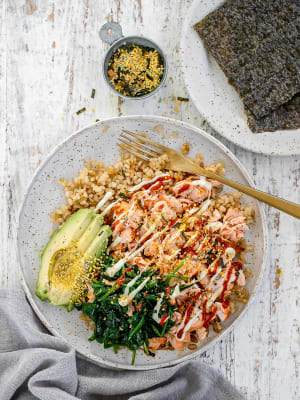The Ultimate Guide to Raising Low Iron Levels

The Ultimate Guide to Raising Low Iron Levels
How to boost your iron levels with food, supplements, and lifestyle changes.
Iron deficiency is one of the most common nutritional deficiencies worldwide, affecting 25 per cent of the world's population. Low iron is also the most common cause of anemia. In this more advanced condition, the body shows measurable drops in hemoglobin and red blood cells and cannot deliver oxygen to various tissues, resulting in dizziness and extreme fatigue. But even in the absence of anemia, iron deficiency can cause a host of other symptoms like low energy, weakness, depression, hair loss, hormonal imbalances, brain fog, and more.
If you've discovered that you're deficient in this all-important mineral, the good news is that raising your iron levels is absolutely doable with a few simple diet, supplement, and lifestyle adjustments. This guide will walk you through everything you need to know about increasing iron levels safely and effectively.
Why Is Iron So Important?
Iron is an essential mineral that plays a fundamental role in the body's overall health, particularly in the production of red blood cells. It forms the central component of hemoglobin, the protein in red blood cells that binds to oxygen in the lungs and transports it to tissues, organs, and cells throughout the body. Without enough iron, the body cannot produce enough healthy red blood cells, leading to a reduced ability to deliver oxygen where it needs to go.
Iron is also involved in:
- Energy production
- Muscle function
- DNA synthesis
- Hormone regulation (including thyroid and adrenal function)
- Immune system support
- Neurological development and cognitive function
Since the body cannot produce iron on its own, we must obtain this essential, life-giving mineral through our diet or supplementation. In fact, iron is not just important for humans; it is a crucial element for all living organisms on earth!
How Much Iron Should You Get?
Iron requirements vary by age, gender, and life stage. The Recommended Dietary Allowances (RDAs) are as follows:
- Men (19-50 years): 8 mg/day
- Women (19-50 years): 18 mg/day
- Pregnant women: 27 mg/day
- Lactating women: 9 mg/day
- Women 51+ years: 8 mg/day
Vegetarians: 1.8 times the RDA due to lower bioavailability of plant-based iron
These numbers highlight the increased iron needs of women of reproductive age due to menstrual blood loss.

What Causes Iron Deficiency?
Several factors can lead to or contribute to low iron levels, including:
- Inadequate Dietary Intake: A diet lacking foods rich in well-absorbed iron can lead to low ferritin (the iron storage protein often used to test iron status on blood panels), iron deficiencies, and even iron deficiency anemia. This is particularly common for vegetarians and vegans.
- Blood Loss: Heavy menstruation, frequent blood donation, ulcers, surgery, or gastrointestinal bleeding can deplete iron stores. The body doesn't have many ways of getting rid of iron, making excess blood loss one of the most significant ways that this precious mineral is lost.
- Malabsorption Issues: Conditions like celiac disease, Crohn's, or past gastric surgeries can interfere with iron absorption. Stealthy health conditions that can cause internal bleeding underscore the need to investigate why iron is low instead of simply replenishing the mineral blindly. This may involve further diagnostic investigation, such as an endoscopy.
- Polyphenol Rich Drinks: Compounds found in tea, coffee, whole grains, and legumes can block iron absorption. Black tea, for example, can block iron absorption by up to 94 per cent! If you take your coffee in the morning, consider taking your iron in the afternoon or evening. In more severe cases, anemic patients are often advised to remove coffee and tea altogether.
- Phytic Acid: Phytates, or phytic acid, found in nuts, seeds, legumes and whole grains, bind to iron, cutting its absorption in half. This poses a challenge to plant-based eaters since many plant-based sources of iron are also high in phytates.
- Alcohol Use: Heavy or even chronic moderate alcohol use can significantly reduce our ability to absorb iron from the gut by damaging the intestinal lining. It can also rob us of folate and vitamin C, both important for iron absorption in their own right.
- Pregnancy & Lactation: The body's iron needs increase dramatically during pregnancy to support the growing fetus. Interestingly, the body's ability to absorb iron also rises dramatically to meet this need- but not enough to compensate for a lack of it in the diet.
- Calcium Supplements: Calcium competes with iron for absorption, making it harder for the body to absorb iron from food or supplements when taken together. It's generally advised, where possible, to space them apart by 1-2 hours.
Using Foods to Raise Iron
Iron comes in two forms: heme iron (found in animal sources) and non-heme iron (found in plant-based sources).
Best Heme Iron Sources:
- Red meat (beef, lamb, venison)
- Organ meats (liver, kidney)
- Poultry (chicken, turkey)
- Seafood (salmon, tuna, shellfish)
Heme iron is absorbed at a rate of 15-35 per cent, making it a much more efficient source of iron. While omnivores get roughly 10-15 per cent of their iron from animal foods, this accounts for almost half of the total iron they actually absorb. Inhibition of iron absorption (ie by phytates or polyphenols), or its promotion (ie by vitamin C) doesn't apply to heme iron- it gets absorbed quite well regardless.
Best Non-Heme (Plant-Based) Iron Sources:
- Dark leafy greens (nori, kale, Swiss chard)
- Sprouted or Fermented Legumes (lentils, beans)
- Fortified cereals and grains (quinoa, teff, amaranth)
- Soy Products (tofu, edamame, tempeh)
- Dried fruits (apricots, raisins)
- Soaked and/or Sprouted Nuts & seeds (sesame, chia, pumpkin seeds, hemp seeds)
Non-heme iron is absorbed at a rate of 2-20 per cent, making it a much less efficient source of dietary iron. Fortunately, there are several ways to increase its bioavailability (see below). Note that even for meat eaters, more than half of daily absorbed iron tends to come from plant sources. This means that making the most of our non-heme iron intake doesn't just apply to vegans or vegetarians!
Enhancing Iron Absorption Unlike heme iron, the bioavailability of non-heme iron is strongly affected by inhibition or promotion, depending on what it's paired with. So, if we get a little clever, we can make a major difference in how much iron we are actually absorbing from the food we eat.

Iron Absorption Boosters:
-
Vitamin C (found in citrus fruits, kiwi, bell peppers, and strawberries) might be the most powerful and important way to increase non-heme iron absorption, lifting it by as much as 600 per cent. Better iron supplements include some vitamin C for exactly this reason.
-
Meat, poultry, and fish and other protein-rich foods can enhance the absorption of plant-based iron when eaten together. This also points to the practical synergy of getting iron from a combination of plant and animal sources.
-
Cooking in cast-iron cookware can boost iron content in food by up to 16 per cent, and has been shown to raise hemoglobin in children. Chefs love cooking in cast iron for culinary impact- but it turns out to be great for anemia-proofing your life, as well!
-
Naturally Processing legumes, grains, or nuts and seeds. Wherever possible, soaking, sprouting, or fermenting these foods is a great way to improve iron absorption. This works by significantly reducing the effect of phytic acids from blocking iron absorption. It also helps liberate other nutrients, like zinc. Prolonged boiling, baking and pressure cooking also destroy phytates.
Supplements, Prescription Iron, Injections and IV
If testing has revealed that you are indeed iron deficient, and you struggle to get enough iron for your personal needs through diet alone, supplementation can be a major ally in restoring iron levels and boosting ferritin on your follow-up bloodwork.
Types of Iron Supplements:
- Ferrous fumarate: A very commonly prescribed form of iron, ferrous fumarate causes the most side effects because it is the most concentrated in elemental iron. Ferrous fumarate is 33 per cent elemental iron, so for 300 mg of ferrous fumarate, 90 mg will be pure iron.
- Ferrous sulphate: The sulphate form is very inexpensive and probably the most commonly prescribed form. Ferrous sulfate is 20 per cent elemental iron, so for every 300 mg, 60 mg will be pure iron. This means it may have fewer side effects than the fumarate version, but may also be slower to raise severely low iron levels.
- Ferrous gluconate: Like sulphate and fumarate, ferrous gluconate is an iron salt and therefore has similar properties. However, gluconate has the least elemental iron of the three at approximately 36 mg for every 300 mg of ferrous gluconate (12 per cent).
- Iron bis-glycinate: This form is an amino acid complex, where iron is bound to glycine molecules. The result is comparable- or possibly superior - absorption to other supplemental forms, with fewer side effects. It also appears to be less affected by absorption inhibitors like phytates and caffeinated drinks. One downside of the bis-glycinate form is that it tends to be more expensive.
- Slow-release iron: These formats are gentler on digestion but may be rather poorly absorbed. For this reason, delayed release iron supplements are generally less preferred.
- Liquid iron: This can contain any of the other forms, and may be a good option for those with digestive issues. However, they may stain teeth- so diluting them in water or orange juice may be a good idea.
How to Make the Most of Iron Supplements:
- Take them on an empty stomach for best absorption (unless unpleasant side effects are experienced).
- Pair them with vitamin C (orange juice, lemon, lime, or a vitamin C supplement).
- Avoid calcium, tea, or coffee around the time of supplement intake.
- Space out your doses. The body absorbs iron more efficiently in smaller doses throughout the day rather than one large dose all at once.
Potential Side Effects of Iron Supplementation:
- Constipation
- Nausea
- Stomach cramps
- Dark stools
If side effects occur, try a lower dose or take iron with food (though this may reduce absorption). Switching to the bis-glycinate form is another option for improving tolerability.
Injection and IV Iron
In cases of severe deficiency or when oral iron is not tolerated, doctors may prescribe intravenous (IV) iron infusions. These provide a rapid increase in iron levels and, since they bypass the digestive tract, can completely avoid gastrointestinal side effects. Alternatively, iron can be injected into a muscle. This may be a little bit more painful and less effective, but it has the advantage of being quicker. Intravenous infusions can take 30 minutes or more.

Other Tips for Raising Iron Levels
Beyond diet and supplementation, additional strategies can round out a holistic approach to maintaining optimal iron levels:
- Optimize gut health: A healthy gut barrier is required for healthy nutrient absorption, and this absolutely includes iron. Conditions like IBS, Crohn's, or intestinal hyperpermeability (leaky gut) can impair iron absorption by reducing the functional surface area of the gut lining. Low stomach acid, which is required for ionizing minerals to enable their absorption in the intestine, can be another very common factor worth attending to.
- Manage inflammation: Chronic inflammation can reduce iron absorption by increasing hepcidin, a hormone that blocks iron uptake. Since systemic, prolonged inflammation is already a significant risk factor in innumerable health conditions, iron is really just one more reason to take it seriously.
- Exercise smartly: Endurance athletes are at a higher risk of iron deficiency due to increased blood turnover and sweat loss.This mainly applies to endurance training, not resistance training. High intensity training also raises hepcidin. By factoring in some recovery time, and taking iron supplements before particularly intense training, instead of after, you can get the best of both worlds.
- Get tested regularly: If you suspect low iron, ask your doctor to add ferritin to your routine bloodwork to check iron stores. To get a more thorough and complete picture of iron status and metabolism, a complete iron panel, which will show other markers in addition to ferritin (the iron storage protein), like serum iron, transferrin (the protein that carries iron through the blood), and total iron binding capacity (which measures the body's ability to bind and transport iron).
Cautions Over Getting Too Much Iron
While iron deficiency is common, iron overload can also be dangerous. Once iron has been absorbed, the body has no mechanism for getting rid of excess iron, which can accumulate in organs, leading to oxidative damage to cells and tissues. This is why getting tested before supplementing iron is extremely important! It's also why follow-up testing, to see how you're responding to iron prescriptions or supplementation, is equally important.
Signs of Too Much Iron:
- Nausea & vomiting
- Stomach pain
- Liver damage
- Increased risk of infections
Safe Upper Limit: The tolerable upper intake level (UL) for iron is 45 mg/day for adults. In times of extreme deficiency, this may be exceeded, but this is only to be done under supervision of a primary healthcare provider.
Summary
Iron is an essential mineral that supports oxygen transport, energy levels, and overall health. Whether you're dealing with a mild deficiency or severe anemia, the right combination of iron-rich foods, strategic supplementation, and smart lifestyle choices can help restore your levels.
If you find out that you're low on iron or even experiencing iron deficiency anemia, it's important to figure out why. But in the meantime, the above science-backed strategies are proven methods for optimizing your iron intake and absorption so you can bring your levels of this precious mineral back into a healthy range and keep them there. Get your body the iron that it needs- no more and no less- and thrive!
Achleithner, S. (n.d.). The Ultimate Guide to Iron. Elo. https://www.elo.health/articles/the-ultimate-guide-to-iron/
Agyeman, V. (2024, January 19). Your Ultimate Guide to Iron – and why it matters. culinahealth.com. https://culinahealth.com/your-ultimate-guide-to-iron-and-why-it-matters/
Alleyne, M., Horne, M. K., & Miller, J. L. (2008). Individualized treatment for iron-deficiency anemia in adults. The American journal of medicine, 121(11), 943–948. https://doi.org/10.1016/j.amjmed.2008.07.012
Bovell-Benjamin, A. C., Viteri, F. E., & Allen, L. H. (2000). Iron absorption from ferrous bisglycinate and ferric trisglycinate in whole maize is regulated by iron status. The American journal of clinical nutrition, 71(6), 1563–1569. https://doi.org/10.1093/ajcn/71.6.1563
Deol, J. K., & Bains, K. (2010). Effect of household cooking methods on nutritional and anti nutritional factors in green cowpea (Vigna unguiculata) pods. Journal of food science and technology, 47(5), 579–581. https://doi.org/10.1007/s13197-010-0112-3
Fischer, J. A. J., Cherian, A. M., Bone, J. N., & Karakochuk, C. D. (2023). The effects of oral ferrous bisglycinate supplementation on hemoglobin and ferritin concentrations in adults and children: a systematic review and meta-analysis of randomized controlled trials. Nutrition reviews, 81(8), 904–920. https://doi.org/10.1093/nutrit/nuac106
Hicks, A. (2020, April 3). How to keep your iron levels up on a vegan (or vegetarian) diet. Stanford Blood Center. https://stanfordbloodcenter.org/keep-iron-levels-vegan-vegetarian-diet/
How do different iron forms compare?. Examine.com. (n.d.). https://examine.com/faq/how-do-different-iron-forms-compare/?srsltid=AfmBOopEzQyvhl-uA3RGe2lIqgKOBKFZfCHccVFQROzp3LO3QFDlhlUv
Hurrell, R., & Egli, I. (2010). Iron bioavailability and dietary reference values. The American journal of clinical nutrition, 91(5), 1461S–1467S. https://doi.org/10.3945/ajcn.2010.28674F
Hurrell, R. F., Reddy, M., & Cook, J. D. (1999). Inhibition of non-haem iron absorption in man by polyphenolic-containing beverages. The British journal of nutrition, 81(4), 289–295.
Iron on a plant-based diet, sources & how to get enough. Pick Up Limes. (2024, August 12). https://www.pickuplimes.com/article/iron-on-a-plant-based-diet-19
Iron-deficiency anemia could be the reason you’re so tired. Cleveland Clinic. (2025, February 19). https://my.clevelandclinic.org/health/diseases/22824-iron-deficiency-anemia
Iron-deficiency anemia. Johns Hopkins Medicine. (2025, February 10). https://www.hopkinsmedicine.org/health/conditions-and-diseases/irondeficiency-anemia
Iron. Linus Pauling Institute. (2025, January 3). https://lpi.oregonstate.edu/mic/minerals/iron
Kulkarni, S. A., Ekbote, V. H., Sonawane, A., Jeyakumar, A., Chiplonkar, S. A., & Khadilkar, A. V. (2013). Beneficial effect of iron pot cooking on iron status. Indian journal of pediatrics, 80(12), 985–989. https://doi.org/10.1007/s12098-013-1066-z
Lee, Y., & Krawinkel, M. (2011). The nutritional status of iron, folate, and vitamin B-12 of Buddhist vegetarians. Asia Pacific journal of clinical nutrition, 20(1), 42–49.
Luo, Y., & Xie, W. (2014). Effect of soaking and sprouting on iron and zinc availability in green and white faba bean (Vicia faba L.). Journal of food science and technology, 51(12), 3970–3976. https://doi.org/10.1007/s13197-012-0921-7 MacCormick, H., Tompa, R., & Jeter Hansen, A. (2023, April 26). Ways to boost blood iron levels while eating a vegan or vegetarian diet. Scope. https://scopeblog.stanford.edu/2017/10/06/ways-to-boost-blood-iron-levels-while-eating-a-vegan-or-vegetarian-diet/
Mayo Foundation for Medical Education and Research. (n.d.). Iron deficiency anemia. Mayo Clinic. https://www.mayoclinic.org/diseases-conditions/iron-deficiency-anemia/diagnosis-treatment/drc-20355040
Milman, N., Jønsson, L., Dyre, P., Pedersen, P. L., & Larsen, L. G. (2014). Ferrous bisglycinate 25 mg iron is as effective as ferrous sulfate 50 mg iron in the prophylaxis of iron deficiency and anemia during pregnancy in a randomized trial. Journal of perinatal medicine, 42(2), 197–206. https://doi.org/10.1515/jpm-2013-0153
Monsen E. R. (1988). Iron nutrition and absorption: dietary factors which impact iron bioavailability. Journal of the American Dietetic Association, 88(7), 786–790.
Nkhata, S. G., Ayua, E., Kamau, E. H., & Shingiro, J. B. (2018). Fermentation and germination improve nutritional value of cereals and legumes through activation of endogenous enzymes. Food science & nutrition, 6(8), 2446–2458. https://doi.org/10.1002/fsn3.846
Pawlak, R., Berger, J., & Hines, I. (2016). Iron Status of Vegetarian Adults: A Review of Literature. American journal of lifestyle medicine, 12(6), 486–498. https://doi.org/10.1177/1559827616682933
Petre, A. (2021, April 9). Iron for vegetarians and vegans; everything you need to know. Veggies & More. https://morethanjustveggies.com/iron-for-vegetarians-and-vegans/
Piskin, E., Cianciosi, D., Gulec, S., Tomas, M., & Capanoglu, E. (2022). Iron absorption: Factors, limitations, and improvement methods. ACS Omega, 7(24), 20441–20456. https://doi.org/10.1021/acsomega.2c01833
Saunders, A. V., Craig, W. J., & Baines, S. K. (2013). Zinc and vegetarian diets. The Medical journal of Australia, 199(S4), S17–S21. https://doi.org/10.5694/mja11.11493
Saunders, A. V., Craig, W. J., Baines, S. K., & Posen, J. S. (2013). Iron and vegetarian diets. The Medical journal of Australia, 199(S4), S11–S16. https://doi.org/10.5694/mja11.11494
Smith, D. (n.d.). Physician’s Guide to Oral Iron Supplements. MemberClicks. https://www.sabm.org/physician-s-guide-to-oral-iron-supplements#:~:text=Ferrous%20sulfate%20is%20the%20least,commonly%20used%20oral%20iron%20supplement.&text=Studies%20have%20shown%20that%20Iron,iron%20but%20are%20more%20expensive
Smith, S. (n.d.). Iron-deficiency anemia: How to increase your iron absorption. EverydayHealth.com. https://www.everydayhealth.com/hs/iron-deficiency-anemia/increase-iron-absorption/
Spadaro, K. (n.d.). Penn State Health Medical Group - Andrews Patel Hematology/Oncology. Penn State Health. https://www.pennstatehealth.org/locations/penn-state-health-medical-group-andrews-patel-hematologyoncology
What’s the difference? ferrous fumarate vs. ferrous sulfate vs. ferrous gluconate: Walk in: Virtual doctors. Walk In - Online Doctors in BC. (2024, November 12). https://walkin.ca/blog/ferrous-fumarate-300-mg/
Yeganeh, S. (2024, September 10). The Ultimate Guide to Maximizing Iron Absorption: A holistic approach to nutrition. MOVABILITY. https://www.movability.ca/blog/2024/9/10/the-ultimate-guide-to-maximizing-iron-absorption-a-holistic-approach-to-nutrition





